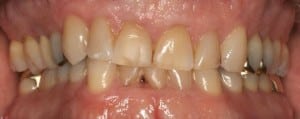
Peter before.
Peter was unhappy with his smile and was having trouble with crowns that he had done (and redone) in the past. Like many of us, Peter turned to the Internet to find his new dentist. Peter thought that Dr. Adler’s website was comprehensive and discussed several issues that he wanted addressed. When Peter came to our office, his teeth were fractured, worn, discolored, crowded and filled with metal fillings that were leaking. He also had bleeding and inflamed gums. His bite was over closed and he had alignment issues. Peter complained that he had pain in his front teeth constantly and had for many years. He also felt that his smile was crooked, discolored and felt stubbly. Peter had spent enough time in the dental chair fixing one tooth at a time. Peter wanted his teeth and gums to be healthy, look great and last a lifetime.
Peter’s fractured teeth, constant pain, over closure and alignment issues were all indications to Dr. Adler that Peter’s bite was not right and would continue to cause problems with his teeth until the issue was resolved. Dr. Adler recommended that Peter have a full mouth reconstruction that would consist of neuromuscular dentistry in conjunction with cosmetic dentistry to insure that his smile would not only look good but be functional and pain free. The phase 1 of Peter’s treatment was to find his ideal bite. The ideal bite places the patient’s plan of occlusion, which is an imaginary line that runs horizontally through the bite, at a 90 degree angel to the patient’s axis of gravity to insure that the forces of gravity and the bite force are distributed equally and don’t cause undue stress or stain on joints and muscles that can effect the entire body.

Before retracted view.
A bad bite caused Peter’s muscles to become overstressed and fatigued due to the constant strain of working in the wrong position. TENS or Transcutaneous Neural Stimulation was used to send electronic pulses to specific muscles in the face, neck, and back that allowed these overstressed muscles to elongate and come into their ideal resting positions. Peter had several TENS sessions during the course of his treatment to insure that the muscles were relaxing into their ideal positions for the best bite. In addition to the TENS, a K7 evaluation was used to help determine exactly where Peter’s ideal bite was and to monitor the progress of his treatment. The K7 evaluation entailed a) taking diagnostic casts of Peter’s mouth, b) running EMG (Electromyography) that measured his muscles at rest and during function-clench, c) CMS (Computerized Mandibular Scan) that displayed joint function, habitual freeway space, swallowing, and range of motion, d) Sonography measured joint sounds, and finally e) Myobite registration, which was an impression of Peter’s bite in its ideal position after TENS has been done. From the myobite, an orthotic was made to keep Peter in his ideal bite. TENS and any needed adjustments were made to the orthotic to make the bite as comfortable and functional as possible. Once Dr. Adler and Peter were satisfied with Peter’s bite, phase 2 of treatment began.
